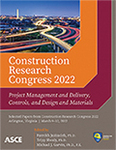Life Cycle Cost Assessment of Green Lightweight Concrete Utilizing Recycled Plastic Based Lightweight Aggregates
Publication: Construction Research Congress 2022
ABSTRACT
The world is experiencing an increasing quantity of plastic wastes, which is becoming a major environmental challenge. Recycled plastics have found their use in construction by replacing natural aggregates in concrete. However, they are not yet well-employed due to the lack of financial studies related to their use. This research aims to evaluate the life cycle cost implications of using recycled plastic based lightweight aggregate (PLA) for applications in concrete structures. Multiple design parameters of conventional concrete and concrete with PLA were used alternately in 24 different scenarios. Using PLA in construction reduced the costs of concrete and steel by 7.23% and 7.18%, respectively. The overall life cycle costs’ reduction reached 8.9%. It was also found that slabs with lengths spanning around four and five meters have higher cost-benefit from using PLA. This study’s findings contribute to the environmental conservation, body of knowledge, and ideological change in the construction field and material development.
Get full access to this article
View all available purchase options and get full access to this chapter.
REFERENCES
Albano, C., Camacho, N., Hernández, M., Matheus, A., and Gutiérrez, A. (2009). Influence of content and particle size of waste pet bottles on concrete behavior at different w/c ratios. Waste Management, 29(10), 2707–2716. https://doi.org/10.1016/j.wasman.2009.05.007.
Alqahtani, F., Khan, M. I., and Ghataora, G. -, 2014.
Alqahtani, F. K., Ghataora, G., Khan, M. I., and Dirar, S. (2017). Novel lightweight concrete containing manufactured plastic aggregate. Construction and Building Materials, 148, 386–397. https://doi.org/10.1016/j.conbuildmat.2017.05.011.
Alqahtani, F. K., and Zafar, I. (2020). Characterization of processed lightweight aggregate and its effect on physical properties of concrete. Construction and Building Materials, 230, 116992. https://doi.org/10.1016/j.conbuildmat.2019.116992.
Alqahtani, F. K., Abotaleb, I. S., and Harb, S. (2021). LEED Study of Green Lightweight Aggregates in Construction. Sustainability, 13(3), 1395.
Asdrubali, F., Baldassarri, C., and Fthenakis, V. (2013). Life cycle analysis in the construction sector: Guiding the optimization of conventional Italian buildings. Energy and Buildings, 64, 73–89. https://doi.org/10.1016/j.enbuild.2013.04.018.
Babu, D. S., Ganesh Babu, K., and Wee, T. H. (2005). Properties of lightweight expanded polystyrene aggregate concretes containing fly ash. Cement and Concrete Research, 35(6), 1218–1223. https://doi.org/10.1016/j.cemconres.2004.11.015.
Freedonia. Global Construction Aggregates - Demand and Sales Forecasts, Market Share, Market Size, Market Leaders (2019). https://www.freedoniagroup.com/World-Construction-Aggregates.html (Accessed 25 December 2020).
Tiwari, G. N., Tiwari, A., and Shyam, Life-Cycle Cost Analysis, in: G. N. Tiwari, A. Tiwari Shyam (Eds.), Handbook of Solar Energy: Theory, Analysis and Applications, Springer, Singapore, 2016, pp. 671–690.
Hannawi, K., Kamali-Bernard, S., and Prince, W. (2010). Physical and mechanical properties of mortars containing PET and PC waste aggregates. Waste Management, 30(11), 2312–2320. https://doi.org/10.1016/j.wasman.2010.03.028.
HomeGuide. Concrete prices| concrete truck delivery costs (per yard) (2020). https://homeguide.com/costs/concrete-prices. (Accessed 25 November 2020).
Islam, H., Jollands, M., and Setunge, S. (2015). Life cycle assessment and life cycle cost implication of residential buildings - A review. Renewable and Sustainable Energy Reviews, 42, 129–140. https://doi.org/10.1016/j.rser.2014.10.006.
Ismail, Z. Z., and Al-Hashmi, E. A. (2008). Use of waste plastic in concrete mixture as aggregate replacement. Waste Management, 28(11), 2041–2047. https://doi.org/10.1016/j.wasman.2007.08.023.
Madlool, N. A., Saidur, R., Hossain, M. S., and Rahim, N. A. (2011). A critical review on energy use and savings in the cement industries. Renewable and Sustainable Energy Reviews, 15(4), 2042–2060.
Marzouk, O. Y., Dheilly, R. M., and Queneudec, M. (2007). Valorization of post-consumer waste plastic in cementitious concrete composites. Waste Management, 27(2), 310–318. https://doi.org/10.1016/j.wasman.2006.03.012.
Omura, A., Todorova, N., Li, B., and Chung, R. (2016). Steel scrap and equity market in Japan. Resources Policy, 47, 115–124. https://doi.org/10.1016/j.resourpol.2016.01.001.
Pappu, A., Saxena, M., and Asolekar, S. R. (2007). Solid wastes generation in India and their recycling potential in building materials. Building and Environment, 42(6), 2311–2320. https://doi.org/10.1016/j.buildenv.2006.04.015.
Peurifoy, R. L. (2010). Formwork for Concrete Structures, 4th Edition. In (Vol. 53, Issue 9).
Rahmani, E., Dehestani, M., Beygi, M. H. A., Allahyari, H., and Nikbin, I. M. (2013). On the mechanical properties of concrete containing waste PET particles. Construction and Building Materials, 47, 1302–1308. https://doi.org/10.1016/j.conbuildmat.2013.06.041.
Saikia, N., and De Brito, J. (2014). Mechanical properties and abrasion behaviour of concrete containing shredded PET bottle waste as a partial substitution of natural aggregate. Construction and Building Materials, 52, 236–244. https://doi.org/10.1016/j.conbuildmat.2013.11.049.
Siddique, R., Khatib, J., and Kaur, I. (2008). Use of recycled plastic in concrete: A review. Waste Management, 28(10), 1835–1852. https://doi.org/10.1016/j.wasman.2007.09.011.
Statista. (2014). “Worldwide plastics production.” _http://www.statista.com/statistics/282732/global-production-of-plastics-since-1950/_ (May 9, 2021).
ISO/TC59/SC14 Committee. ISO 15686-5:2008: Buildings and constructed assets–Service-life planning Part 5: Life-cycle costing, International Organization for Standardization, 2008.
Xuan, Y., and Yue, Q. (2016). Forecast of steel demand and the availability of depreciated steel scrap in China. Resources, Conservation and Recycling, 109, 1–12. https://doi.org/10.1016/j.resconrec.2016.02.003.
Information & Authors
Information
Published In
History
Published online: Mar 7, 2022
Authors
Metrics & Citations
Metrics
Citations
Download citation
If you have the appropriate software installed, you can download article citation data to the citation manager of your choice. Simply select your manager software from the list below and click Download.
